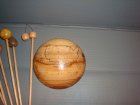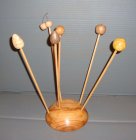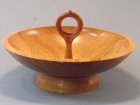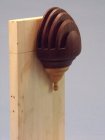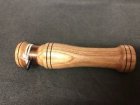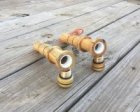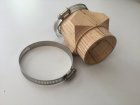I enjoy turning new forms and objects. I like turning bowls and hollowforms but exploring new forms is a lot of fun when it works out.
A new form for me in 2017 is a copy of Anasazi seed jars. These are split hollowforms 6-7” diameter that have very small openings that I can sand carve to recreate seed jars. The one with the turkey figure around the opening and kokapelis on the bottom is turned from plain looking camphor. The black one is turned from plain poplar. The reddish one is turned from eucalyptus. The form itself is derived from a similar one I saw Lyle Jamieson turn around 2000.




2013 I played around with 3 and 2 sided napkin rings. Have never seen anyone else do this but it is so simple it seems likely some would have. Just turn a multi sided spindle. Part in smaller than the through hole. Drill the through hole to separate the rings.

2007 I played around with a ball in a ball. Larger ball is hollowed to hold the smaller ball. The opening is then englarged to a tiny bit smaller than the diameter of the smaller ball. The small ball is given a tap. The elasticity of wood lets the ball pass through the opening. The opening closes trapping the small ball inside.
I can’t find any reference to this being done by anyone else. Since it is the same process as the bodger chair joint it is very likely someone did it before I did. This idea developed from a discussion with David Springett.

2004 I developed a way to turn suspended spherical forms. A sphere in the center is hollowedmin a vacuum chuck
The profiles of the end parts are turned. For example the fishtail on this form is made by turning apogee and slice the side off with a bandsaw then sanding. The tentacle is turned cove profile that is cut on the bandsaw following the outside curve. This is an original form. The example below Is sycamore 15” length - center sphere is 7” diameter. This idea came from a scoop demo by Soren Berger. I thought about making a two handled scoop then about going bigger making the center element hollow.

A few new items I turned on the Lathe.
Check out Trent Bosch’s work to see true creative genius.










